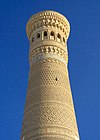Tashkent Planetarium
"Toshkent Planitariumi" | |
 | |
| Established | 7 November 2003 |
|---|---|
| Location | |
| Type | Public, technological planetarium |
Tashkent Planetarium is one of the newest constructions in Uzbekistan, which is visited by local people and by tourists. Tashkent Planetarium provides visitors with the opportunity to look at outer space, even in the morning, and enlarge their knowledge about the cosmos and the whole universe.[1]
About
Tashkent Planetarium was established by edict №649 of "Cabinet of Ministers of Republic Uzbekistan" on 3 November 2003, by decision of Tashkent city municipality of 7 November 2003 №748. The Planetarium is nowadays controlled by the controlling unit of Tashkent city municipality which focuses on culture and sport.
There are two main halls at the Planetarium, and each hall has its own functions. The first hall is mainly built for showing the Solar System and space, using Japanese technologies. The second hall contains artefacts, where visitors can learn more about specific planets and about Earth.
In 2008 a group of scientists at Tashkent Planetarium discovered the new planet "Samarkand".[2][3][4]
See also
- State Museum of History of Uzbekistan
- The Museum of Health Care of Uzbekistan
- The Museum of Communication History in Uzbekistan
- Museum of Arts of Uzbekistan
- Tashkent Museum of Railway Techniques
- Museum of Geology, Tashkent
- Art Gallery of Uzbekistan
- The Alisher Navoi State Museum of Literature
- Museum of Victims of Political Repression in Tashkent
- State Museum of Nature of Uzbekistan
References
- ^ "Планетарий г. Ташкента в г. Ташкент (Узбекистан): фото, описание, адрес на карте - необычные достопримечательности". prostoturist.com.ua. Retrieved 1 April 2016.
- ^ "Астрономы из Узбекистана открыли малую планету "Самарканд" - Anons.uz". ANONS.UZ. Retrieved 1 April 2016.
- ^ "Каталог TOP - Мой Город". mg.uz. Retrieved 1 April 2016.
- ^ "Планетарий г. Ташкента :: Информация об интереснейших местах посещения Ташкента". orexca.com. Retrieved 1 April 2016.


